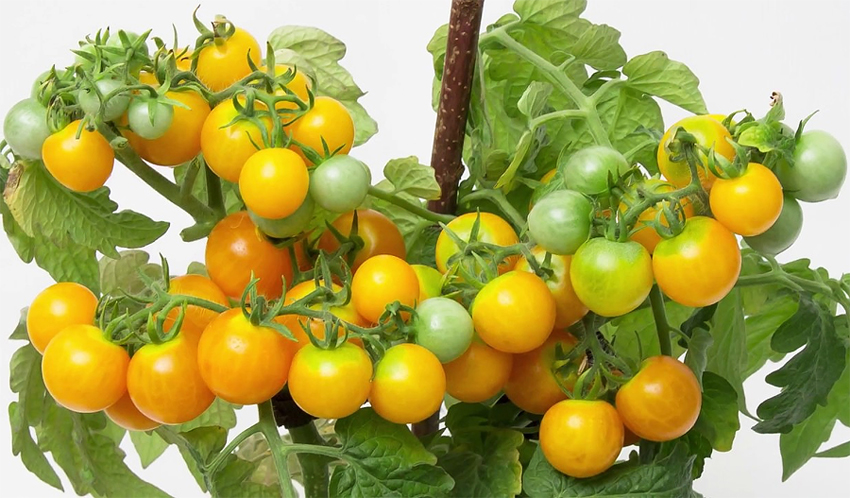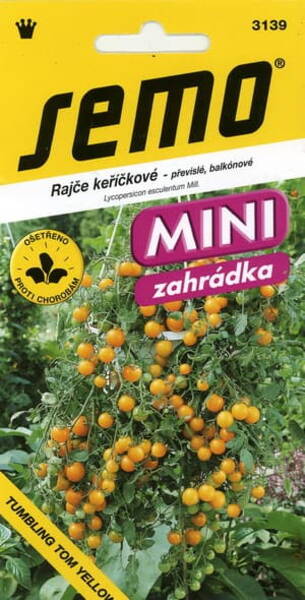Bush tomato - spreading for patios, pots and baskets. Early cherry tomatoes from a compact bushy plant with spreading habit. Excellent taste.

How to grow tomatoes at home?
What is the first thing that comes to mind when the phrase: a vegetable garden on the windowsill? Probably, most people will imagine rows of pots with compact tomato bushes ...
Yes, this plant does great as a container crop.
Moreover, there are many varieties, adapted just for the conditions of the balcony or window sill. However, in order for the tomato to develop well and give a rich harvest, it must be properly grown.
Choosing a tomato variety for growing on a windowsill.
Tomato varieties are very diverse. They all fall into two large groups:
Indeterminate. These are tomatoes with unlimited growth, they can reach 2-3 meters in height. Most often cultivated in greenhouses.
Determinant. Varieties with limited growth. Upon reaching a certain height, they stop in development, directing all forces to the development of already formed brushes.
There is also an intermediate stage - semi-determinant.
So, only determinant varieties are suitable for rooms and balconies, no more than 60-70 cm high. They are compact, with a small root system. They require less soil volume than tall ones. It is easier to look after them.
The best option is a determinant standard grade that does not require garters and pinching. Such plants form as small trees with a strong stem. Since growth is limited, the number of brushes that can form is also limited. In this case, stepchildren are also capable of producing crops. However, if they take away all the plant's forces on themselves, then it is better to remove them all the same.
Planting indoor tomatoes.
You can plant potted tomatoes starting in the second half of January, at which time daylight hours begin to arrive. And until the middle of summer, in order to get a harvest for the new year (however, if you have phytolamps, you can plant it all year round).
You can plant seeds in different ways:
* Directly into pots with soil. If this is a permanent pot in which the plant will live for the rest of its life, then it is worth filling it with soil no more than 2/3. As the tomatoes grow, soil will need to be added, so free space is necessary.
* In peat tablets. The tablets take up little space, do not require any containers (except for the pallet), and contain everything necessary for the development of the plant in the first weeks of life. In the tablet, the tomato feels good until it is transplanted into a permanent pot (together with the tablet, it is better to remove the mesh from it). The only drawback of this method is that the peat dries up very quickly, you need to monitor this all the time and water it often.
* Germinate first. This method is convenient in that you do not need to mess with the ground, take up space with those seeds that will not sprout. The pots will go exactly what is 100% viable. You can germinate seeds in wet sand or sawdust, in vermiculite or perlite, between two cotton pads, in toilet paper, etc. The main thing is to constantly moisturize the selected material.
Seeds of tomatoes usually sprout from 3 to 10 days. When planting in the ground, they should be buried by 1.0-1.5 cm. To create the optimal temperature and humidity, you can cover with a film, airing every day.
Caring for potted tomatoes:
* The optimum room temperature is from 18 to 28 degrees Celsius. Tomatoes also tolerate heat well, but when they reach 35 degrees, the pollen becomes sterile, and the tomatoes stop setting. But the temperature drops to + 12 + 14 degrees, especially for 5 or more hours, they do not like tomatoes at all. If it is cold on the balcony at night, then it is worth covering the bushes with agrofibre, non-woven material or film.
* Lighting should be bright, tomatoes like light. However, in the heat, direct sunlight will be undesirable, in this case it is better to partially shade the bushes.
* Watering - plentiful, as needed. Do not water the tomatoes every day, keeping the soil moist all the time. The best watering regimen for tomatoes is once every 3-5 days or more. You should look at the state: if the soil is completely dry from above, and the leaves are slightly softened, then it's time to water.
* Grades above 30 cm may require a garter. Especially if the plant has a lot of brushes with fruits. Then it will lean to one side. To prevent this from happening, you should install some kind of support and tie up a bush.
* Even if you do not need to pinch the plant, you should pick off excess leaves from it: all wilted, yellowed, stained and diseased. It is also recommended to pick off the lower leaves before the first cluster of fruits. This will improve ventilation and light flow. In addition, the plant will spend less nutrients on greens, and more on fruits.
* As the tomato grows, air roots (“pimples” with a light color) appear on its stem at the base. To make the plant stronger, to increase the volume of its root system, you should periodically pour fresh soil into the pot, closing these air roots.
Spraying tomatoes is not worth it.
This procedure is advisable only as a treatment from pests, diseases and for foliar feeding. To increase fruit setting, tap the trunks of the plants every morning. Shaking will improve the shedding of the pollen and its hitting the pistils.
Top dressing of indoor tomatoes.
At the seedling stage, during the period of growing green mass, fertilizers with a predominance of nitrogen and phosphorus are used for tomatoes. Top dressing on the balcony is carried out every two weeks. During the period of bud formation, flowering, fruit setting, potassium should prevail in fertilizers. Top dressing is carried out every 7-10 days. Good results can be achieved by alternating mineral fertilizers with organic ones.
Of the complex mineral compositions, "Kristalin" has proven itself well, and for increasing fruit set - "Zavyaz".
Of organic fertilizers, tomatoes love ash, infusion of banana peel, yeast brew, infusion of rye bread.
* WHY ARE THE SEEDLINGS NOT GROWING?
If the seedlings have stopped growing, "frozen," as they say, and turned yellowish, something is wrong with the soil. Look closely; the surface may be covered with a yellowish salt deposit; often, a bloom of algae appears.
If you remove the plant from the ground and examine its roots, you'll find them very poorly developed. Eventually, they die off completely, and the plant dies. This is caused by the soil's pH being too high, meaning it's becoming alkaline. Plants won't thrive in acidic soil either.
In such conditions, tomato seedlings acquire a reddish-blue color, and the roots are also barely developed.
Sometimes, once the cotyledon leaves have unfurled, growth stops. Furthermore, overly acidic soil (even disinfected) can lead to clubroot or blackleg disease in cabbage seedlings.
Peat soils are usually acidic. Vegetable garden soils are also often acidic. Wood shavings also acidify the soil.
ADVICE: To reduce soil acidity, add lime or dolomite flour to the soil: for tomato, pepper, and eggplant seedlings, 15-17 g per 1 kg of soil; for cucumber, zucchini, and other cucurbit seedlings, 25-30 g. When adding lime, it is recommended to supplement it with fertilizers containing magnesium – this will improve the quality of the seedlings.
When alkalizing the soil, add apple cider vinegar or citric acid to the water - this will help the plant absorb nutrients.












